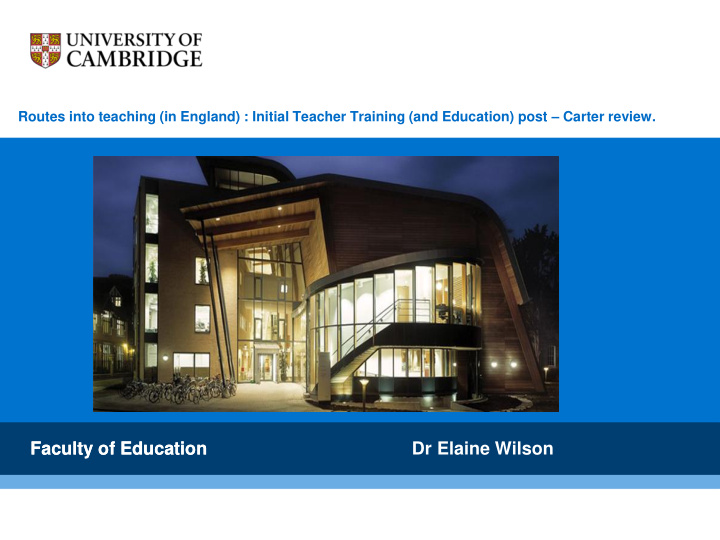



Routes into teaching (in England) : Initial Teacher Training (and Education) post – Carter review. Faculty of Education Faculty of Education Dr Elaine Wilson
Ongoing debates about entry, routes, content and assessment of training Concurrent or consecutive pre - service teacher courses? Training in subject and Pedagogy? Initial Teacher Training and Education? ‘Competences’ or ‘Standards’? ‘Soft’ or ‘hard’ accountability? Reform or transform? Faculty of Education
New entrants to primary and secondary routes (England) 45,000 40,000 35,000 30,000 25,000 20,000 15,000 10,000 5,000 0 2009/10 2010/11 2011/12 2012/13 2013/14 2014/15 2015/16 New entrants, primary New entrants, secondary Total Faculty of Education
Change in route uptake 2014 – 2016 (%) School Direct (Salary) School Direct (Fee) 2015 - 16 SCITT: School - led 2014 - 15 PGCE: University - led Teach First 0 10 20 30 40 50 60 70 Source: ITT census 2015 – 2016 Faculty of Education
2015 – 2016 New Teacher Allocation and Uptake Data University SCITT SD Fee SD Salary Total 17,066 3,718 13,577 5,134 39,495 Allocated 13,561 2,372 7,086 3,166 26,185 Uptake -3,505 -1,346 -6,491 -1,968 -13,310 Not filled % under 21% 36% 48% 38% 34% recruitment Source: Howson Faculty of Education
University of Cambridge – Secondary School Partnership 2010 Wilson, E. (2012) Building social capital in teacher education through university – school partnership. In M. Evans, (Ed) (2012) Teacher Education and Faculty of Education Pedagogy : theory, policy and practice . Cambridge, Cambridge University Press.
The Partnership in 2016 Faculty of Education
In summary: what universities add to teacher education • Enhanced subject knowledge • Pedagogical Content Knowledge • Knowledge of research methods • Access to research knowledge • Support to develop a ‘critical antenna’ • Academic support to integrate practice and research knowledge • Social support during placements and beyond • Time and space to collaborate and think Faculty of Education
Recommend
More recommend